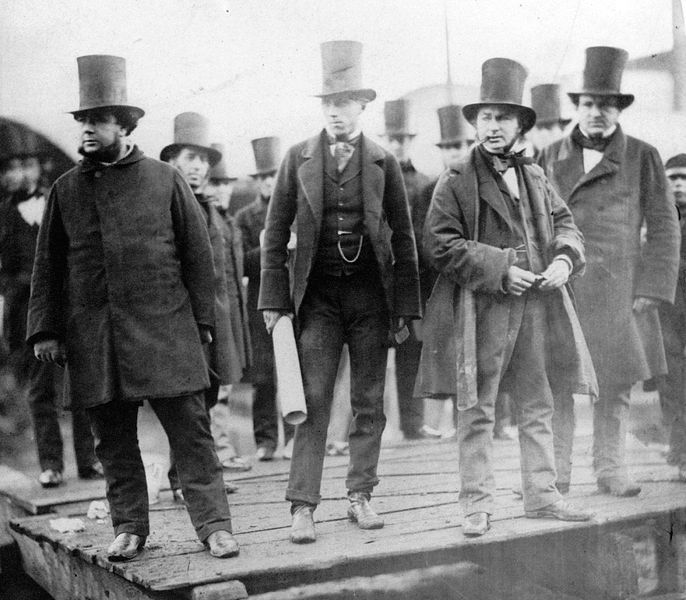
Spend some time dwelling within the political corners of the internet, and it won’t be long until you come across a persistent “-ism” that refers to our current economic system. And that “-ism” is, of course, Capitalism! Defined as an economic system characterized by private ownership, free markets, and profit-driven production. It’s the system that we live and breathe, from the time we get up to the time we lay our heads on the pillow—it’s the reason why vast numbers of people across the globe get up for work the next morning.
At the heart of this system lies its fundamental driving force: the capitalist class and their unwavering interest in the art of producing to sell. Fuelled by the pursuit of profit and the accumulation of capital, this unyielding motive has birthed a revolutionary era of mass production, where economies of scale are harnessed through the concentration of numerous workers under a single roof—be that a factory or a supermarket. The relentless march of efficiency is propelled by the marvels of machinery and the strategic division of labour among the workforce.
Becoming wealthy from inheriting a fortune from a recently deceased uncle and thereafter seeing that bank account cha-chinging to the six figures does not magically make somebody a capitalist, though depending on the special way that large sum of money is used can make them one.
There’s a popular caricature of the capitalist portrayed as some British Victorian fellow wearing a black top hat and waistcoat, peering down his factory floor watching his workers scurrying beneath in haste for the productive activity that will earn them their wage. What we have in mind here is the commonly perceived archetype of an industrial capitalist—the influential figures who own expansive factories, advanced machinery, and vast tracts of land. These big capitalists are at the forefront of industrial production, shaping entire industries and commanding significant economic power.
We know it’s not the ‘clothes that make the man’ and viewing class distinctions solely through the shallow lens of someone’s outer presentation is ridiculous. It is not the façade of opulent appearances that makes one a capitalist, but their functional role within the capitalist mode of production. What makes a capitalist a capitalist depends on that person’s relationship to the means of production—factories, machinery, land, or other productive resources, which is also called capital. This is what separates them from the masses, their mode of coveting income, and their way of getting money derived from the ownership of capital. Unlike the majority of people (the working class) who are compelled to find an employer to work a job, if we have individuals or groups (such as the board of directors) who privately own and exercise control over the means of production then they are definitely members of the capitalist class and it is this ownership that allows them to organize and direct economic activities.
Granted we may agree that the industrial capitalists are the big capitalists as they own the means of production and employ many workers, but capitalists come in all shapes and sizes and I’m not talking about their BMI. The industrial capitalists, while they encompass the prominent figures who own large-scale means of production, represent only a segment of the capitalist class. Capitalism extends beyond these big capitalists, encompassing a broader range of actors who engage in profit-driven economic activities.
Consider a small-scale garment production business owned by an entrepreneur, let’s call her Sarah. Sarah operates a workshop equipped with sewing machines and employs a team of skilled workers to produce garments for the market. Although her operation may not rival the magnitude of the big capitalists who own the large factories, nevertheless, the fundamental principles of capitalist production and labour exploitation are unmistakably present.
Firstly, Sarah’s ownership and control of the means of production, namely the workshop and sewing machines, exemplify the pivotal role she plays as a capitalist. As the owner, she has the authority to organize and direct the production process according to her business objectives.
Secondly, Sarah’s business model relies on profit generation through the exploitation of labour. By employing workers and paying them wages for their work, she taps into their labour power to create value. The garments produced by her workers hold a value that surpasses the wages they receive. Sarah appropriates this surplus value as profit, reinforcing her status as a capitalist.
Thirdly, Sarah actively engages in capitalist production. She utilises her ownership of the means of production, the workshop and sewing machines, to orchestrate the production of garments. The objective of her enterprise extends beyond mere creation; she seeks to accumulate capital and generate profits through the sale of these garments in the market.
Despite the modest scale of Sarah’s business, these defining characteristics align with the core principles of capitalist production and class relations within a capitalist system. It highlights that being a capitalist transcends the scale of operations and underscores the importance of understanding the underlying dynamics of capitalist production and labour exploitation.
And then there are those capitalists who do not own any means of production at all! I’m talking about the merchants. They for instance can be considered capitalists in the sense that they engage in the buying and selling of goods for profit. They act as intermediaries between producers and consumers, leveraging market dynamics to generate wealth. Supermarkets and retail shops of varying hues play a crucial role in the circulation and exchange of commodities within the capitalist system, especially in service sector dominated economies like modern Britain which now can truly be called ‘a nation of shopkeepers’ as Napoleon allegedly said.
I know a retired steel worker friend who’s worked for 40 years. But he owns a large amount of shares from investing over the years and gets paid dividends, is he a capitalist? Yes and no, although he may not be directly involved in the production process, employ wage labour or own the means of production like the big wig industrial capitalists, he is still engaging in the circulation of capital and seeking to accumulate wealth through financial investments. The profits he receives in the form of dividends are the result of his capital being deployed in the market, and returning back to him in greater value. As illustrated in Das Kapital, Karl Marx introduces the general formula for capital = M-C-M’, and it’s this is what is common to all capitalist activity. In the M-C-M’ formula, “M” represents money, “C” represents commodities, and “M'” represents an increased amount of money or profit. This formula encapsulates the cyclical nature of capitalist production and exchange, where money is invested in the purchase of commodities (such as raw materials, goods, shares or financial instruments) in order to create more value and generate profit through their subsequent sale or interest. The commodity that is bought serves as capital because its utility is solely as a means to expand value, or in other words—profit. Wealth in the form of money is repetitively pursued.
For industrial capitalists, the formula can be seen in the investment of money (M) to acquire the means of production and labour power (C), which are then employed to produce commodities. These commodities are subsequently sold in the market, resulting in an increased amount of money (M’) in the form of profit. The cycle then repeats as the capitalist reinvests the accumulated capital to expand production and generate further profit.
Similarly, for merchants, the formula applies to their role in buying commodities (M), such as goods or products, and then selling them at a higher price (M’) to make a profit. The merchant capitalizes on the difference between the buying and selling prices to accumulate wealth.
And here we come to the stock market investors, where my friend folds his arms in contentment. Even in their case, the general formula of capital remains relevant. When investors purchase stocks or financial instruments (C) using their money (M), they do so with the expectation of selling them at a later point for a higher price (M’) and realizing a profit.
This highlights the versatility of the M-C-M’ formula and its applicability to different forms of capitalist activities. From industrial capitalists to merchants to stock market investors, the underlying motive is to use capital to generate profit and accumulate wealth.
This is why we should be using the term primary capitalists. Just like the industrial capitalists who come under this category, they are those who own businesses and employ wage labour to generate profits. They occupy a significant position within the capitalist system, as they possess and control the means of production, organize labour, and accumulate capital through the extraction of surplus value. Their decisions regarding investment, production techniques, pricing, and market strategies have far-reaching implications for both their businesses and the wider economic landscape. They are the ones chiefly targeted on Marxist propaganda posters. Lastly, it’s the employment of wage labour that is crucial here because this is how we can differentiate primary capitalists from other forms of capitalists, such as sole traders or small-scale entrepreneurs like Del Boy from the television show “Only Fools and Horses.”
So there you have it, we’ve taken a deep dive into the captivating world of capitalism and its class of protagonists (or perhaps antagonists if you’re a Marxist!). From the bigwig industrial capitalists to the cunning merchants and savvy stock market investors, we have witnessed the intricate dance of wealth creation and accumulation.
Throughout our exploration, we have unravelled the core principles that drive the capitalist engine. It’s all about ownership and control, my friend. Those who possess the means of production hold the reins of power, shaping the milieu of entire landscapes and channelling economic activities. The pursuit of profit, fuelled by the exploitation of labour, sets the stage for a symphony of value creation.
But let’s not forget the rogues who defy the traditional stereotype. Take our entrepreneur Sarah, furnished with her sewing machines and a vision. She may not boast massive factories or sprawling empires, but her small-scale garment business exemplifies the essence of capitalist production. She orchestrates her workshop, turning the wheels of labour to spin profits and fuel her ambitions.
And who can overlook my retired friend and his treasure trove of shares? While he may not be knee-deep in the production process, his capital works for him in the market, seeking to grow and multiply. Marx profoundly revealed in his age-old formula of money turning into commodities, which, in turn, blossoms into more money. The pursuit of wealth knows no bounds.
As we wrap up our exploration, let’s remember that across the globe we live and breathe capitalism. Towns and cities lined with billboards and commercials plastered on screens are frequent phenomena of our daily lives, because they reflect the economic ideology of the ruling class. Even though you have never met the owners of the firm you may be working for, you are working to make the owners richer and for now it’s the only game in town—or should I say the world!

